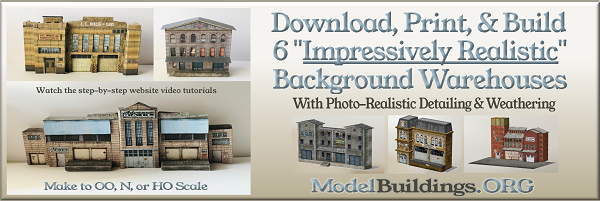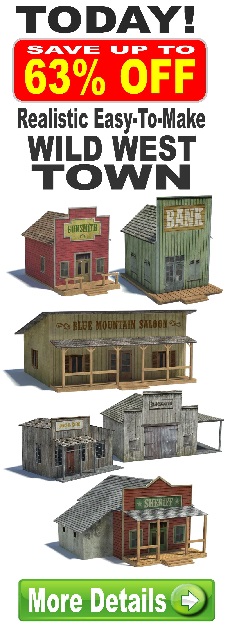Everything on model trains, model railroads, model railways, locomotives, model train layouts, scenery, wiring, DCC and more. Enjoy the world's best hobby... model railroading!
How to Fix Problem When Locomotive Passes Over Remote Switches
Kevin asks readers:
“I have an N-scale railroad which includes about a half-dozen Atlas remote switches. When the locomotive passes over a few of the switches, there is unevenness that causes a brief interruption in the motion of the locomotion. Is it possible to use a fine sandpaper to smooth out the track so that the locomotive passes over the switch smoothly? Or is there a better solution? Thanks in advance for any advice that is offered.”
11 Responses to How to Fix Problem When Locomotive Passes Over Remote Switches
Leave a Reply
















just a thought your first check would be to ensure your tracks are lined up perfectly in the track joiners as if they are out there will be a bump between rails as this has been the cause for some of my rail misalignment .ps. use all new couplers/joiners as some times old ones get bent and will also cause misalignment
Thanks very much Allan. I will check the alignment of the tracks as you have suggested.
Kevin, I used to have several switches in a row and I only had one connection to power, As the engine passes more switches it would loose power and slow down and also act like it was not getting good connections through the switches. If this is the case then I suggest that you might want to put feeder wires up to the rails in between each switch to ensure good power on each side of each switch. After I connected extra power connections I then had decent power all the way through the switches and the engines ran steady through them. That is assuming that what Allen says might not fix your situation. I am going on the idea that if rail drag is not the problem through the switches, then a power loss could still look like it.
Don’t know if you are using frog powered switches or standard
from Newman
Thanks Newman. I do not have switches in a row in my layout. I am using standard powered switches.
Kevin take a track gauge and check the proper clearance through the whole switch Even store bought could be off gauge. Depending on your wheels look for flanges that stick down too far or something lifting the wheels uo as the pass over the switch. Sometimes a flat file along the track can level out the top of the rail that might not have got set into the ties when it was molded. from Newman
The above comments are very good. There is another possible cause for an ‘alignment’ problem. Laying the track in the first place. With N gage, there cannot be any unevenness with the roadbed at all. It must be level and flat. The slightest irregularity in the sub roadbed can cause issues. Just as big a problem in N is how you secure your trackage.If you nail it down, it is quite easy to get the nail too tight and cause a deflection OR not in far enough. Get a long carpenter’s level and check for unevenness along the way. Turnouts in N are subject to all the above mentioned possibilities.
I model in HO and have had 3 Atlas #4 turnouts that caused derailments/interruption of power to the loco. I realigned them and checked everything over and over until I finally ripped them up and replaced with Shinohara turnouts. NO MORE PROBLEMS!
Joe, I no Longer use nails or screws to set my track. In some instances nails were working loose and even screws I didn’t like sticking up. I now use APEX Clear caulk for a lot of things It holds well, you can shift what you are mounting for several minutes, If you need to take it back up I use a thin putty knife and slide it under the ties and each pass going farther under the rail ties. The same with roadbed without damaging the roadbed. Switches I spread thin a coat of APEX Caulk and in two or three areas under the switch that is not so important which holds well and still be able to get it up if you have to. No more stapling cork down and no more nails. That makes using foam roadbed much better too. APEX caulk works well with Styrofoam scenery old ceiling tile for rock formations cast rocks, tunnel portals, You can find it at several hardware stores and especially Menard’ where it is the cheapest so far. it goes on white and dries clear. If I need to shim road bed I fit a peice of thin cardboard under the roadbed and the track does not pull into the roadbed.
It keeps the track from having bobbles . If weighting the track down to dry use a flat strip bar of wood or mental and weight on it so it does not push down the track just where the weight is. The only thing I use small nails for is to hold a short section of track in place that would go between modules till the track dries on each side of it. 20 minutes you are moving farther down the right of way. Spread a coat on the bottom of the roadbed before you lay it. On the touching edge of the other half. After the roadbed is set then a thin coat on top of the roadbed and set the track in place on top. from Newman
Thanks Joe. I will check for any unevenness as you have suggested. I am hopeful that I do not have to replace the Atlas switches.
With older engines the wheels are deeper. Check the plastic frog for wheels lifting up in the frog. If so file the plastic frog.
Had the same problem with the Atlas turnouts and found the problem to be horizontal spacing with a track gauge. The pilot truck on an Athern 4-6-6-4 was raising as it would pass over the switch. After checking closely I found the whole front driver slightly lifting as it passed over the inner turn outlet. Not only were the front driver wheels too close by .002 inch but the tracks were about .004 inch too close. This was causing the whole engine to lift as the flanges of the wheels were trying to climb to the top of the rails and lifting the whole body. A feeler gauge set showed almost .005 inch of lift of the whole front truck. Use the N scale gauge and check everything very closely. Use a flash light and close inspection even a mirror to look at the opposite sides at the same time.
hi kevin, as you can see from all of the comments above alignment and making sure the track is perfectly level, not just level in length but also across the track. Whilst you’re gauging your track don’t forget the wheels on the rolling stock.